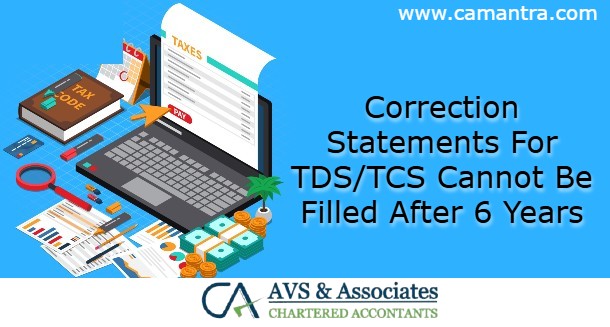Filing TDS (Tax Deducted at Source) and TCS (Tax Collected at Source) returns accurately is essential for ensuring smooth credit flow and tax compliance. But even the most meticulous filers can make mistakes — an incorrect PAN, mismatched challan details, or wrong deduction amount. Thankfully, the Income Tax Department allows the filing of correction statements to fix such errors.
What many taxpayers may not realize is that correction statements for TDS/TCS can typically only be filed within six years from the end of the relevant FY. And missing this timeline can lead to irreversible issues.
What Is the Six-Year Rule?
The Centralized Processing Cell (CPC-TDS) and Income Tax Department systems are designed to accept corrections only within a six-year window from the end of the financial year in which the original TDS/TCS statement was filed.
Example:
If you submitted a TDS return for FY 2017–18 (ending March 31, 2018), you could file corrections only up to March 31, 2024. After that, the correction utility typically becomes unavailable.
Why Does This Time Limit Exist?
The six-year restriction is not arbitrary — it serves important policy and operational goals:
- Finality of Records: Tax records need closure at some point to ensure consistency and legal certainty.
- Administrative Efficiency: Processing corrections indefinitely would strain system resources and increase backlog.
- Encouraging Timely Action: A clear deadline motivates deductors/collectors to review and rectify errors proactively.
What Happens If You Miss the Correction Deadline?
Failing to file a correction within the six-year limit can lead to long-term complications — especially for the deductee or person whose tax credit is affected.
Key consequences include:
- Mismatch in Form 26AS/26Q-TDS/26Q-TCS: Errors left uncorrected may prevent proper reflection of TDS/TCS in the deductee’s records, leading to issues while filing their income tax returns.
- Refund Delays or Demand Notices: Incorrect PAN or amount details could delay income tax refunds or even trigger demand notices for unpaid taxes.
- Reconciliation Challenges: Errors from years past can create discrepancies in books, making audits and reconciliations difficult for all parties involved.
What Should You Do?
To avoid falling into this compliance trap, proactive monitoring is key. Here’s how you can stay on top of things:
- Reconcile Periodically:
Ensure that the tax deducted/collected matches what’s reflected in the government’s database. Reconciliation should be a routine activity, not a year-end scramble. - Check Form 26AS and 26QLTD:
Encouraging regular reviews of tax credit statements by employees, vendors, and other deductees can help identify errors while corrections are still possible. - Act Immediately on Errors:
As soon as you notice an error in your filed TDS/TCS return, don’t wait. File a correction through the TRACES portal while it’s still allowed.
Time is a Critical Factor
The six-year limit for filing TDS/TCS correction statements underscores the importance of accuracy and prompt action in your filings. Avoid turning simple mistakes into permanent issues by staying vigilant, reviewing your statements regularly, and addressing errors as soon as they are detected. Proactive compliance not only prevents complications but also ensures smooth credit flow and peace of mind.

